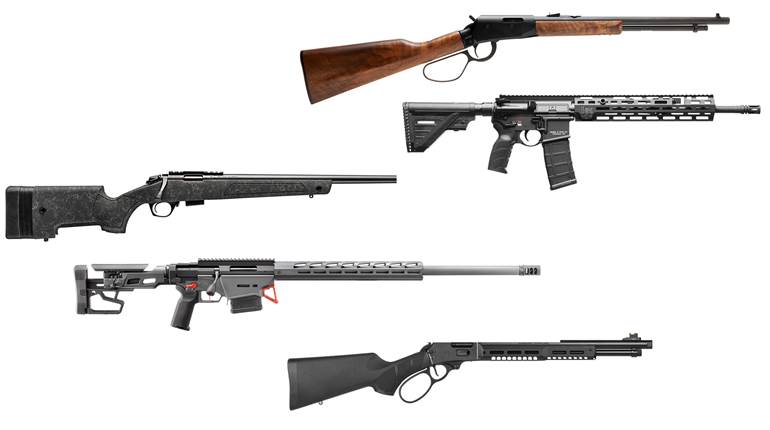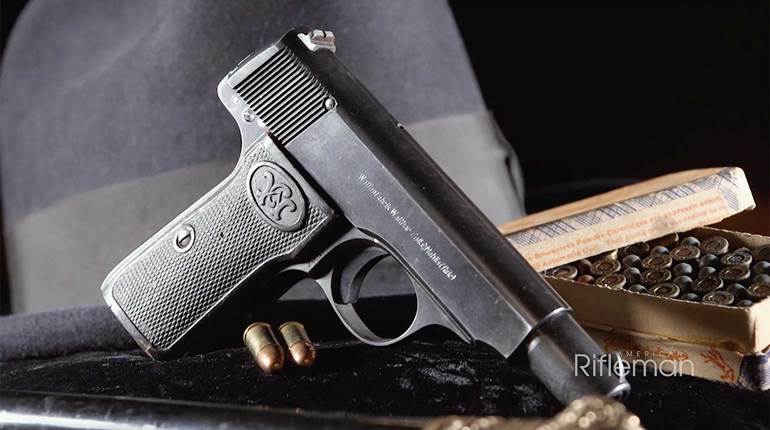
On November 20, 1917, two full Corps of British troops assaulted the Hindenburg Line at Cambrai, France. More than 1,000 guns thundered out a preparatory barrage. Through the smoke of the bursting shells, German troops were surprised to see nearly 400 British tanks crawling towards their positions, crushing wire entanglements beneath their tracks, and overwhelming strongpoints with machine gun and cannon fire.
Deployed in large numbers for the very first time, the tanks made a significant impression. The Germans had no specialized weapons to combat them, and only select units of the Kaiser’s army had any experience with anti-tank tactics.
The targets: British Mark IV tank (“Female” machine gun armament only).
The British made significant gains that first day, and, by their standards, suffered comparatively light casualties for the advance (about 4,000 casualties that day). Among the tanks, 65 British Mark IVs were destroyed on day one. However, another 120 tanks were out of action, most from mechanical breakdown or bogged down in deep shell holes. The Mark IV tank was notoriously unreliable.
The targets: British Mark I tank (“Male”, cannon armament).
German reinforcements quickly filled in the gap, and the British offensive bogged down. German artillery was able to interdict many of the most suitable areas for tank operation. Still, Allied planners saw the great potential of the armored vehicle to break the stalemate on the Western Front. Offensive planning began anew.
The T-Gewehr compared to the U.S. M1917 rifle.
The breakthrough potential of the British tanks made a great impression on the Germans as well. More tank attacks would be coming, and soon. The Kaiser’s men set about developing specific anti-tank tactics and weapons to stop them. Thus began the century-old battle of the infantryman versus the tank, and the never-ending search for man-portable weapons to get the better of the armored beast.
The 13.2 mm Tank Abwehr Gewehr M1918.
In response to the new Allied armored threat, Waffenfabrik Mauser AG quickly designed and produced a special rifle to fight tanks: the 13.2 mm Tank Abwehr Gewehr M1918, or “T-Gewehr.” The world’s first anti-tank rifle was not particularly complex. Essentially nothing more than an oversized Mauser bolt-action rifle, the T-Gewehr was a single-shot weapon chambered for the new 13.2 x 92 mm TuF (Tank Und Flieger, or tank-and-aircraft) semi-rimmed and bottlenecked cartridge. The projectile was a jacketed round with a steel core. Its sights were graduated out to 500 meters.
Comparison of the Mauser rifles of World War One.
Breakdown comparison of the standard Mauser rifle and the T-Gewehr.
T-Gewehr is a massive rifle, 66.5” long and weighing 41 lbs. with its bipod. The stock is quite thick and thus a pistol grip was added to provide an adequate hand-hold. There is no muzzle brake, and nothing exists to help reduce the painful recoil. Wartime users generally claimed it to be an uncomfortable weapon to shoot. (Modern shooters have recorded several videos of firing the T-Gewehr, and many of these can be found on Youtube.com).
Big brother: the T-Gewehr is essentially a massive version of the standard Mauser rifle. 
Bipod for the T-Gewehr.
Combat performance of the T-Gewehr is the subject of some debate. Wartime claims are that the 13.2 mm AP ammunition (with a muzzle velocity of 2,600 f.p.s.) could penetrate 22 mm of armor plate at 100 meters. It is important to note that the plate would have to be angled at 90 degrees for this level of performance. Any slope to the tank’s armor, or the addition of “spaced-armor” plates, would significantly degrade the T-Gewehr’s penetrative capability. Full penetration of the armor was not necessary to inflict casualties on the crew—hammering blows to the face of the armor plate could cause spalling or scabbing inside, sending small fragments of steel ricocheting about inside the tank’s metal box superstructure.
The targets: British Mark A “Whippet.”
The targets: The French Saint-Chamond.

The targets: The French Schneider CA 1 (seen here supporting the U.S. 1st Division).
The targets: the French Renault FT-17 (seen here in U.S. service with the 327th Tank Battalion).
The armor thickness of Allied tanks varied, with the British Mark IV protected by 12 mm of armor plate (much of it at right angles), the Mark A “Whippet” had 14 mm of armor maximum, while the French Saint-Chamond had 11 mm sloped armor at the front, with 17 mm on the slab sides, the Schneider CA1 had 11 mm of armor all around, and later models added a 5.5 mm spaced-armor shield to cover the front. The most numerous tank in the decisive battles of late 1918 was the French FT-17, a light tank which featured armor that ranged from 8-22 mm.
Rare image of the T-Gewehr in action in a German trench. Note the massive amount of dust kicked up by the AT rifle’s heavy muzzle blast.
The new anti-tank rifles began to arrive in the hands of combat troops in May 1918, and by mid-September more than 4,600 T-Gewehr rifles had been delivered to the Western front. German infantry divisions had more and more specially trained and equipped anti-tank units embedded within their ranks by the summer of the Great War’s final year.
By 1918, many German riflemen and MG08 teams were supplied with the armor-piercing S.m.K. bullets to provide greater defense against Allied tanks.
German anti-tank tactics progressed rapidly throughout 1918. Most of the Allied tanks were slow and cumbersome and when caught without infantry support, they were vulnerable to tank-killer teams armed with bundled grenades and satchel charges. Germany also produced the armor-piercing S.m.K. Spitzgeschoß mit Kern (roughly “spitzer with core" bullet), which gave good performance (2,575 f.p.s.) at reasonable range. S.m.K. rounds were issued to riflemen in anti-tank units, and many German machine gun teams received at least a belt or two of the AP ammo. Light artillery and mortars were deployed forward into likely tank attack areas and the T-Gewehr rifles arrived in ever increasing numbers. More than 15,000 were produced by Mauser by the end of the war. 
A Doughboy of the 77th Infantry Division displays a rather rusty T-Gewehr captured in the Ardennes on November 1, 1918.
Doughboys of the 80th Division display their war trophies: German body armor, the Mauser Gewehr 98 standard rifle, and the Mauser 13.2 mm T-Gewehr anti-tank rifle. October 5, 1918.
In the decisive battles in the autumn of 1918, the Allies cracked the Hindenburg Line with a powerful combination of tanks, artillery and aggressive infantry assaults, bolstered by America’s entry into the war. The T-Gewehr was not up to the challenge to stop the Allied onslaught, but it did open the door to a new world of specialized, high-velocity anti-tank weapons. The infantryman’s war against the tank had just begun.






































